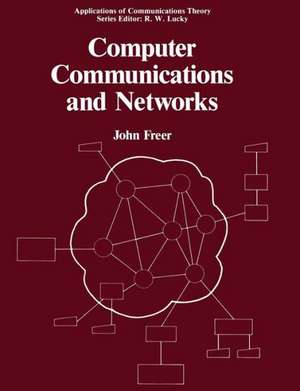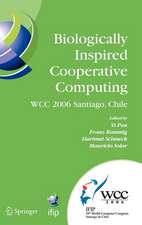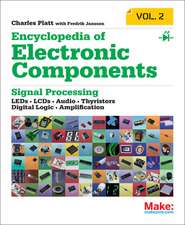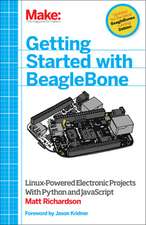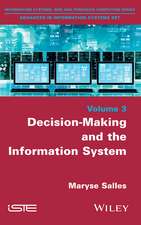Computer Communications and Networks: Applications of Communications Theory
Autor John R. Freeren Limba Engleză Paperback – 30 sep 2011
Din seria Applications of Communications Theory
- 15%
 Preț: 645.60 lei
Preț: 645.60 lei - 15%
 Preț: 641.71 lei
Preț: 641.71 lei - 18%
 Preț: 956.18 lei
Preț: 956.18 lei - 18%
 Preț: 2105.61 lei
Preț: 2105.61 lei - 18%
 Preț: 1243.92 lei
Preț: 1243.92 lei -
 Preț: 393.74 lei
Preț: 393.74 lei - 18%
 Preț: 2487.11 lei
Preț: 2487.11 lei - 18%
 Preț: 953.35 lei
Preț: 953.35 lei - 15%
 Preț: 650.86 lei
Preț: 650.86 lei - 18%
 Preț: 1228.96 lei
Preț: 1228.96 lei - 15%
 Preț: 649.39 lei
Preț: 649.39 lei - 18%
 Preț: 1392.95 lei
Preț: 1392.95 lei - 18%
 Preț: 1243.92 lei
Preț: 1243.92 lei - 18%
 Preț: 963.77 lei
Preț: 963.77 lei - 18%
 Preț: 957.75 lei
Preț: 957.75 lei - 20%
 Preț: 337.32 lei
Preț: 337.32 lei -
 Preț: 401.79 lei
Preț: 401.79 lei - 20%
 Preț: 341.81 lei
Preț: 341.81 lei -
 Preț: 388.13 lei
Preț: 388.13 lei - 20%
 Preț: 339.99 lei
Preț: 339.99 lei - 18%
 Preț: 962.49 lei
Preț: 962.49 lei - 18%
 Preț: 958.56 lei
Preț: 958.56 lei - 18%
 Preț: 1394.52 lei
Preț: 1394.52 lei -
 Preț: 410.07 lei
Preț: 410.07 lei
Preț: 346.10 lei
Preț vechi: 432.62 lei
-20% Nou
Puncte Express: 519
Preț estimativ în valută:
66.23€ • 71.92$ • 55.64£
66.23€ • 71.92$ • 55.64£
Carte tipărită la comandă
Livrare economică 22 aprilie-06 mai
Preluare comenzi: 021 569.72.76
Specificații
ISBN-13: 9781461283058
ISBN-10: 1461283051
Pagini: 448
Ilustrații: X, 432 p.
Dimensiuni: 189 x 244 x 24 mm
Greutate: 0.79 kg
Ediția:Softcover reprint of the original 1st ed. 1988
Editura: Springer Us
Colecția Springer
Seria Applications of Communications Theory
Locul publicării:New York, NY, United States
ISBN-10: 1461283051
Pagini: 448
Ilustrații: X, 432 p.
Dimensiuni: 189 x 244 x 24 mm
Greutate: 0.79 kg
Ediția:Softcover reprint of the original 1st ed. 1988
Editura: Springer Us
Colecția Springer
Seria Applications of Communications Theory
Locul publicării:New York, NY, United States
Public țintă
ResearchCuprins
1 Data communication concepts and alternatives.- 1.1 Trends in computer communications and networks.- 1.2 Messages, characters, bit streams, symbols and waveforms.- 1.3 Digital/analog, serial/parallel, simplex/half-duplex/full-duplex.- 1.4 Synchronous/asynchronous.- 1.5 Parity/CRC/LRC/EDC/ARQ.- 1.6 Character/byte-count/bit-oriented data link control protocols.- 1.7 Balanced/unbalanced interfaces.- 2 Communications media.- 2.1 Introduction.- 2.2 Electrical cable.- 2.3 Fibre optic cable.- 2.4 Free-space optical links.- 2.5 Radio and microwave links.- 2.6 Satellite relay.- 3 Modems and multiplexers.- 3.1 Modulation and keying alternatives.- 3.2 Modems.- 3.3 Multiplexing alternatives.- 3.4 Multiplexers and concentrators.- 3.5 Error performance.- 4 Network topologies, switching and access control.- 4.1 Network topology and topography.- 4.2 Link switching techniques.- 4.3 Network access control.- 5 Layered network architectures.- 5.1 Introduction.- 5.2 Open Systems Interconnection reference model.- 5.3 Alternative network architectures.- 5.4 DEC Digital Network Architecture (DNA).- 5.5 IBM Systems Network Architecture (SNA).- 5.6 Comparison of DNA and SNA.- 6 Interface standards.- 6.1 Introduction.- 6.2 RS-232-C and V.24/V.28.- 6.3 RS-449, RS-422, RS-485 and RS-423.- 6.4 X.20, X.21 and X.21 bis.- 6.5 X.3, X.28, X.29.- 6.6 IEEE 488 (IEC 625).- 7 Local area networks.- 7.1 Local communication alternatives.- 7.2 Broadband local area networks.- 7.3 IEEE 802.2 logical link control.- 7.4 IEEE 802.3 CSMA/CD LAN.- 7.5 IEEE 802.4 token bus LAN.- 7.6 IEEE 802.5 token ring LAN.- 7.7 ANSI FDDI dual fibre optic ring.- 7.8 MIL-STD-1553 B avionic data bus.- 8 Wide area network standards.- 8.1 Long-distance communication alternatives.- 8.2 BISYNC (BSC) character-controlled protocol.- 8.3 DDCMP character-count protocol.- 8.4 SDLC bit-oriented protocol.- 8.5 HDLC bit-oriented protocol.- 8.6 CCITTX.25.- 8.7 Protocols for mobile radio links.- 8.8 Videotex (viewdata).- 9 Performance prediction.- 9.1 Introduction.- 9.2 Link performance.- 9.3 Wide area network performance prediction.- 9.4 Local area network performance prediction.- 9.5 Network reliability and availability prediction.- 10 Computing and software issues.- 10.1 Introduction.- 10.2 Distributed data processing.- 10.3 Network software.- 10.4 Distributed databases.- 10.5 PC-to-mainframe links.- 10.6 CCITTX.400.- 10.7 Data compression.- 11 Threats to communications security.- 11.1 Introduction.- 11.2 Passive attacks.- 11.3 Active attacks.- 11.4 System penetration ploys against dial-up systems.- 11.5 Countermeasures.- 11.6 Port protection.- 11.7 Encryption.- 11.8 Trusted computers and networks.- 11.9 Security in the open systems architecture.- 12 Network implementation.- 12.1 Requirements analysis and architectural design.- 12.2 Implementation options.- 12.3 System integration.- 12.4 Network protection and reconfiguration.- 12.5 Network management and testing.- Appendix: Data communications standards.- References.
